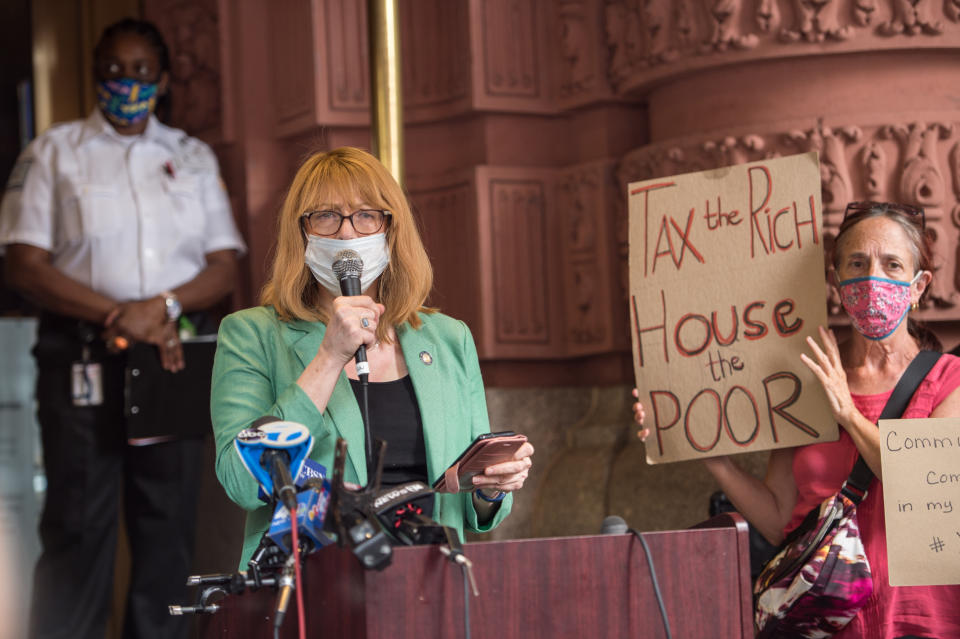‘Gone in 90 minutes:’ Rental assistance is quickly running out for struggling renters
Rental assistance for struggling renters is quickly running out, and it remains unclear whether new funding will be replenished any time soon.
“Every single state has issues,” said Mariel Block, a staff attorney at the National Housing Law Project, a nonprofit legal and housing authority. “Houston saw their rental assistance gone in 90 minutes.”
Read more: Here’s how to negotiate with your landlord if you’re facing eviction
More than a third of city and county level rental assistance programs across the country are closed or on hold, according to a tracker from the National Low Income Housing Coalition, a research and advocacy nonprofit. Nine of the 56 state programs have also run out of funding. In Arkansas and Alabama, state and local assistance programs are no longer accepting applications for aid.
Not only does this hurt renters who are seeking assistance now, but it could also mean those who defer payments under the Trump administration’s new eviction moratorium won’t have any help paying the back rent owed to their landlords after the moratorium expires on December 31.

‘Programs are oversubscribed’
Even though the CARES Act provided $5 billion through community development block grants and $150 billion in relief funds, only limited resources remain.
The $155 billion combined wasn’t dedicated just to rental relief, so states and cities carved out what they could from these funds to create their own emergency rental programs to meet demand. They’ve also leaned on donations from community philanthropic resources.
Read more: Here's what you need to know about the new eviction moratorium
“We've had 235 new emergency rental assistance funds in the last few months but 25% of them have closed their doors to applicants because they’ve depleted their funds,” said Diana Yentel, President at NLIHC.
Many of these programs had only weeks to get the emergency rental assistance off the ground, Block said, noting they didn’t have sufficient staff to get up and running, publicize, and turn the funds around fast.

Funds often were given out to whoever reached out first, rather than by need.
“The programs are oversubscribed and some were even first come, first serve,” Block said. “They’re oversubscribed in a matter of hours.”
‘Programs require landlords to consent’
Even those renter who can access rental assistance may face roadblocks if their relationship with their landlord isn’t an amicable one.
“A lot of programs require landlords to consent to participation in order to receive rental assistance,” Block said. “So if a landlord wants to discriminate, they can pretty easily do so by saying I’m not going to accept the rental assistance.”
Read more: Coronavirus: Here's what to do if you can’t pay rent
Rental aid is also a “patchwork” solution, Block said, with requirements for access differing depending on the state, county, or city you live in.
“Hopefully there is information on [your] local government’s website,” Block said. “But, unfortunately, timing is really everything and it depends on if there is funding available.”

‘Disappointed Congress couldn’t get together’
After the initial eviction moratorium expired in July and before President Trump’s executive action, nearly 30 million Americans were at risk of losing their homes, according to a study by the Aspen Institute, a think tank. Trump used the authority of the Centers of Disease Control and Prevention to extend the moratorium through December 31.
Read more: Coronavirus stimulus checks: What’s stopping a second round of payments?
But the order doesn’t excuse renters from the amounts owed — in addition to any late fees — once the moratorium lifts. Additionally, some renters may not opt for the moratorium because of the more stringent eligibility requirements and threat of jail time if the declaration form is not filled out correctly.
“I think the forms may scare off people who actually are eligible and need this protection,” Yentel said.
So, additional funding is needed now and when the moratorium expires, according to housing advocates. It would also help landlords who depend on the payments as well as renters.
“$100 billion is the minimal amount that we need to keep renters in stable houses,” Yental said. “The more conservative estimates based on what we know today run anywhere from $7-12 billion a month to keep low-income renters stable until jobs come back.”
In June, Sen. Maxine Waters (D-CA) introduced the Emergency Housing Protections and Relief Act — which includes an extra $100 billion in funding for rental assistance — but the bill has yet to be taken up on vote in the Senate.
The pending status of additional rental relief reflects a larger stalemate between Democrats and Republicans on the next coronavirus stimulus package.
On Thursday, the Republican’s Coronavirus Relief Plan — dubbed a “skinny” proposal and didn’t include rental assistance — failed to pass the Senate, with Democrats largely blocking the bill because it was too small in scope.
“We were disappointed Congress couldn’t get together,” said Paula Cino, vice president of the construction, development and land use policy at the National Multifamily Housing Council, a trade organization. “This administration’s approach is just a stop-gap measure and is very problematic.”
Dhara is a reporter Yahoo Money and Cashay. Follow her on Twitter at @Dsinghx.
Read more:
‘Not a rent holiday’: Trump’s new eviction order leaves renters on hook for back pay
Coronavirus: Trump administration attempts to prevent evictions using CDC quarantine authority
President Trump's promises to prevent evictions offers ‘false hope,’ experts say
Read the latest financial and business news from Yahoo Finance and Yahoo Money
Follow Yahoo Finance on Twitter, Facebook, Instagram, Flipboard, SmartNews, LinkedIn, YouTube, and reddit.

 money
money 
